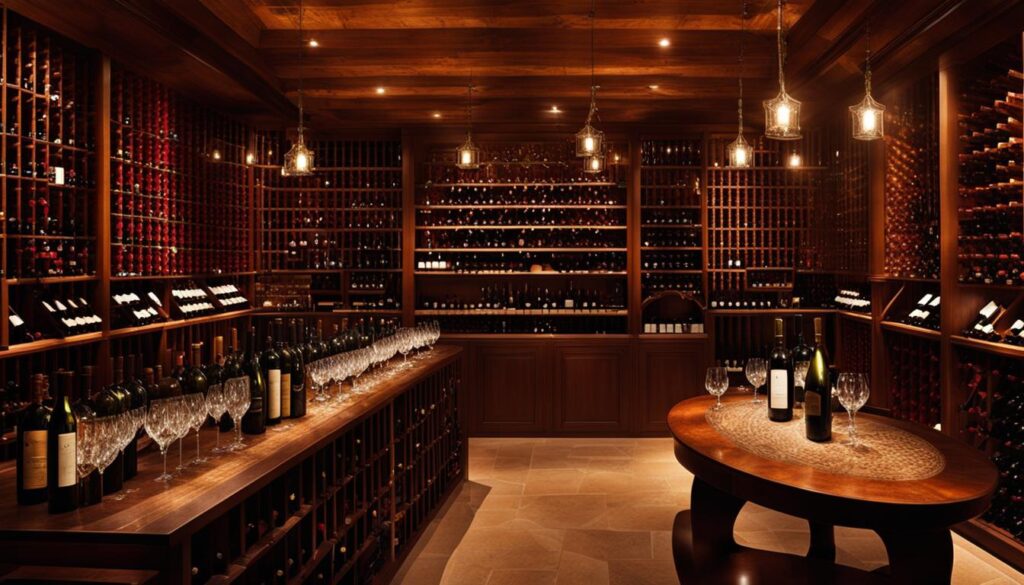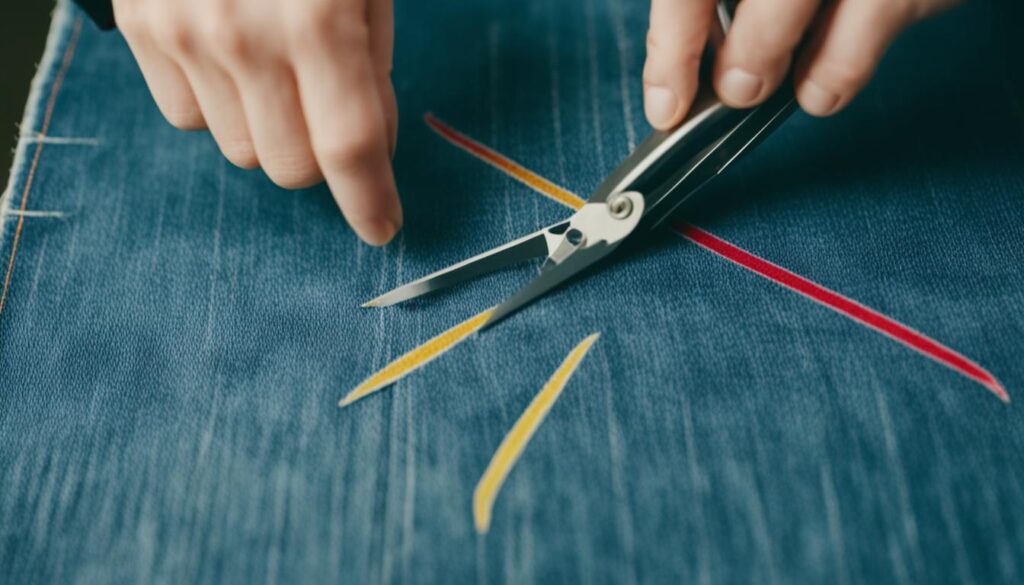Fine wine collecting is an art that allows enthusiasts to curate an exclusive cellar and elevate their connoisseurship. With expert tips and guidance, individuals can develop a deep appreciation for the nuances of fine wines and build a valuable collection. By delving into the world of fine wine collecting, connoisseurs can explore different regions, grape varieties, and vintages, and gain insight into the intricacies of winemaking. This article will provide essential information and insights to help you master the art of fine wine collecting.
Key Takeaways:
- Fine wine collecting is a journey that enhances connoisseurship.
- Expert tips and guidance are essential for building a valuable collection.
- Exploring different regions, grape varieties, and vintages enhances the collecting experience.
- Proper cellar management is crucial for preserving the quality of wines.
- Valuing and investing in fine wines can be a lucrative opportunity.
The Basics of Fine Wine Collecting
Before embarking on your fine wine collecting journey, it is important to understand the basics. This includes selecting the right wines for your cellar, ensuring proper storage conditions, and considering the investment potential of your collection.
Fine wine collectors should pay attention to the provenance of the wines they acquire, ensuring that they are sourced from reputable sellers and have a reliable history. By mastering these fundamental aspects of fine wine collecting, you can build a strong foundation for your collection.
1. Selecting the Right Wines for Your Cellar
When building your wine collection, it’s essential to choose wines that align with your tastes and preferences. Consider the different wine regions, grape varieties, and vintages that interest you. Research and explore the characteristics of each wine to ensure they complement your collection.
Remember to choose wines that have a good aging potential and will develop complex flavors over time. Some wines are meant to be enjoyed young, while others benefit from aging.
2. Ensuring Proper Storage Conditions
Proper storage conditions are critical to preserving the quality of your fine wines. Ideally, wines should be stored in a cellar or wine refrigerator with a consistent temperature between 55 and 60 degrees Fahrenheit (13-15 degrees Celsius).
Humidity levels should be maintained around 70% to prevent the corks from drying out. Excessive dryness can lead to oxidation and spoilage of the wine. Additionally, minimize exposure to light and vibrations, as they can degrade the wine’s quality.
3. Considering the Investment Potential
While collecting fine wines can be a passion, it can also be a sound investment. Some wines appreciate in value over time, making them valuable assets. Research the market trends and consult experts to make informed decisions about which wines have investment potential.
Part of assessing the investment potential involves evaluating the reputation of the winery and the rarity of the wine’s vintage. Wines from renowned producers and limited-production vintages tend to have higher demand and command higher prices.
4. Paying Attention to Provenance
The provenance, or the history of ownership and storage conditions, is crucial when collecting fine wines. Ensure that the wines you acquire have a traceable and reliable provenance. This ensures that the wines have been stored properly and have not been subjected to unfavorable conditions that could compromise their quality.
5. Creating an Organized Cellar Inventory
To effectively manage your collection, it’s important to keep an organized cellar inventory. Maintain a record of the wines you own, including details such as vintage, producer, and storage location. This helps you keep track of your collection and enables you to access specific bottles easily when desired.
“Fine wine collecting offers the opportunity to curate an assortment of exquisite wines that reflect your personal taste and passion. By understanding the basics and implementing proper storage practices, you can ensure that each bottle in your collection is a cherished piece of art that continues to appreciate in value.”
By following these guidelines, you can embark on your fine wine collecting journey with confidence and build a cellar that showcases your discerning taste and passion for the art of wine.
Building a Diverse Collection
A key aspect of fine wine collecting is building a diverse collection. By exploring different wine regions, grape varieties, and vintages, collectors can truly enhance their experience and appreciation of fine wines.
Discover the World of Wine Regions
When building your collection, it’s important to include wines from various regions. Each wine region has its own unique characteristics and terroir, which can impart distinct flavors and aromas to the wines produced there. Consider adding wines from renowned regions such as Bordeaux, Burgundy, and Napa Valley to your collection. This allows you to explore the differences in terroir, climate, and winemaking techniques, providing a diverse range of flavors and experiences.
Expand Your Horizons with Grape Varieties
Collecting wines made from different grape varieties is another great way to diversify your collection. From the bold and robust Cabernet Sauvignon to the elegant and aromatic Pinot Noir, each grape variety offers its own unique flavor profile. Including wines made from various grape varieties allows you to broaden your understanding of the world of wine and discover new favorites along the way.
Embrace the Essence of Vintages
Vintage variation is a fascinating aspect of fine wine collecting. Wines from different vintages can exhibit variations in flavor, structure, and aging potential. By including wines from a range of vintages, you can witness the evolution of wines over time and appreciate the impact of weather conditions on the final product. Some wines have exceptional aging potential, developing complex flavors and increasing in value over the years. Be sure to consider the aging potential of the wines in your collection and allow them the time they need to reach their full potential.
“Building a diverse collection allows collectors to explore the rich tapestry of the wine world, uncovering the unique stories and flavors that each bottle holds.”
Proper Cellar Management
Proper cellar management plays a critical role in maintaining the quality and value of your fine wine collection. By implementing the right techniques, you can ensure that your wines age gracefully and retain their unique characteristics. Let’s explore some key aspects of cellar management:
Temperature Control
Temperature control is paramount in preserving the integrity of your wines. It is recommended to maintain a consistent temperature between 55 and 60 degrees Fahrenheit (13-15 degrees Celsius). Fluctuations in temperature can accelerate the aging process or even cause spoilage. A reliable wine cellar cooling system is essential to achieve and maintain the desired temperature.
Humidity
Humidity levels are another crucial factor to consider. Keeping the humidity around 70% helps to keep the corks moist, preventing them from drying out and allowing air to enter the bottle. This protects your wine from oxidation, ensuring that it matures gracefully over time.
Lighting
Ultraviolet (UV) rays present in natural and artificial light can be harmful to wine. Exposure to light can degrade the wine and affect its flavors. It is advisable to minimize the amount of light that reaches your cellar by using dark glass or keeping bottles in wine racks with solid walls. This will protect your collection from light damage and preserve its optimal quality.
Organization
An organized cellar makes it easier to access and enjoy your fine wines. By organizing your collection by region, grape variety, or vintage, you can quickly locate specific bottles and keep track of your inventory. Consider using wine racks, storage bins, or software applications specifically designed for cellar organization.
Proper cellar management is key to maintaining the quality and value of your fine wine collection. By paying attention to temperature control, humidity levels, lighting, and organization, you can ensure that your wines age gracefully and provide you with delightful experiences throughout their maturation process.
| Temperature Control | Humidity | Lighting | Organization |
|---|---|---|---|
| Maintain a consistent temperature between 55 and 60 degrees Fahrenheit (13-15 degrees Celsius). | Keep humidity levels around 70% to prevent corks from drying out and protect wine from oxidation. | Minimize exposure to light to prevent UV damage and degradation of wine. | Organize cellar by region, grape variety, or vintage for easy access and tracking. |
Valuing and Investing in Fine Wines
Fine wine collecting offers more than just the pleasure of indulging in exquisite flavors and aromas. It can also be a profitable investment endeavor, providing collectors with the opportunity to grow their wealth while pursuing their passion. Understanding how to value wines and assess their investment potential is essential for collectors looking to take advantage of this lucrative market.
When determining the value of a fine wine, several factors come into play. Brand reputation plays a significant role, with renowned wineries commanding higher prices due to their established track record of producing exceptional wines. Vintage rarity also contributes to a wine’s value, as older vintages become scarcer over time. Critical acclaim is another crucial aspect, as wines that have received favorable reviews from reputable critics tend to appreciate in value.
Staying informed about market trends is vital for fine wine investors. By continuously monitoring the market, collectors can identify emerging trends and make informed decisions about which wines to acquire. Additionally, staying abreast of industry news and developments allows investors to adjust their strategies accordingly.
“Investing in fine wines is not just about the wine itself but also the market surrounding it. It’s about understanding the demand and supply dynamics, tracking market trends, and making strategic choices based on that knowledge.”
One avenue that collectors can explore to enrich their wine portfolio is participating in wine auctions. Wine auctions provide access to rare and sought-after bottles that may not be readily available in retail stores. Participating in these auctions allows collectors to acquire unique wines and potentially realize substantial returns on their investment.
The investment potential of fine wines has been proven over time, with many collectors reaping significant returns on their portfolios. However, it’s important to note that investing in fine wines carries risks, as with any investment. Market fluctuations, changing consumer preferences, and unforeseen events can all impact the value of a wine collection. Therefore, it is crucial for investors to conduct thorough research, seek expert advice, and diversify their portfolios to mitigate risks.
By understanding the valuation and investment aspects of fine wine collecting, collectors can make informed decisions that enhance the value of their collection. Whether you are a wine enthusiast looking to turn your passion into an investment opportunity or a seasoned collector seeking to expand your portfolio, fine wine investing offers a unique blend of pleasure and potential profits.
Conclusion
Fine wine collecting is a rewarding journey that allows enthusiasts to develop their connoisseurship and curate an exclusive cellar. Whether you are a seasoned collector or just starting out, mastering the basics is key. Building a diverse collection that showcases different wine regions, grape varieties, and vintages will enhance your understanding and appreciation of fine wines. Effective cellar management, including maintaining the right temperature, humidity, and proper organization, ensures the preservation of your valuable collection.
Understanding the valuation and investment potential of fine wines can also add another dimension to your collecting journey. By staying informed about market trends and participating in wine auctions, you can uncover rare and sought-after bottles that can appreciate in value over time. Expert tips and guidance are invaluable in this pursuit, providing you with the knowledge and insights to make informed decisions.
So, whether you are captivated by the allure of fine wine collecting or simply eager to elevate your connoisseurship, don’t hesitate to embark on this artful journey. Start building your cellar, explore the world of fine wines, and enjoy the pleasures that come with being a fine wine collector. Cheers to the joys of fine wine collecting!
FAQ
What is fine wine collecting?
Fine wine collecting is an art that allows enthusiasts to curate an exclusive cellar and elevate their connoisseurship. It involves collecting and appreciating fine wines from different regions, grape varieties, and vintages.
What are the basics of fine wine collecting?
The basics of fine wine collecting include selecting the right wines for your cellar, ensuring proper storage conditions, considering the investment potential, and paying attention to the provenance of the wines.
How can I build a diverse collection of fine wines?
Building a diverse collection involves exploring different wine regions, grape varieties, and vintages. By including wines from various regions and grape varieties, you can experience the unique characteristics and flavors of each type of wine.
What are the important aspects of proper cellar management?
Proper cellar management includes maintaining a consistent temperature between 55 and 60 degrees Fahrenheit, controlling humidity levels at around 70%, minimizing exposure to light, and organizing your cellar for easy access and tracking.
How can I value and invest in fine wines?
Valuing and investing in fine wines involves considering factors like brand reputation, vintage rarity, and critical acclaim. Monitoring market trends and staying informed about the industry can help collectors make informed decisions. Wine auctions are also a popular avenue for buying and selling fine wines.
















